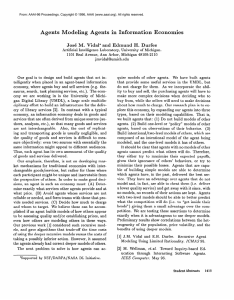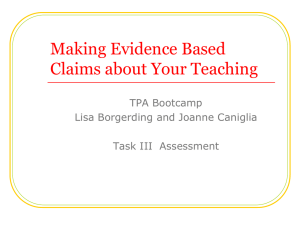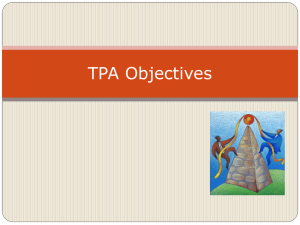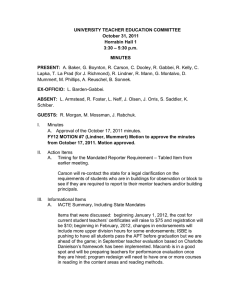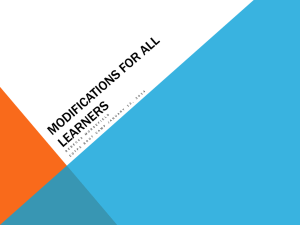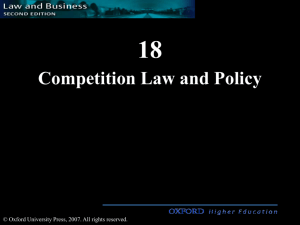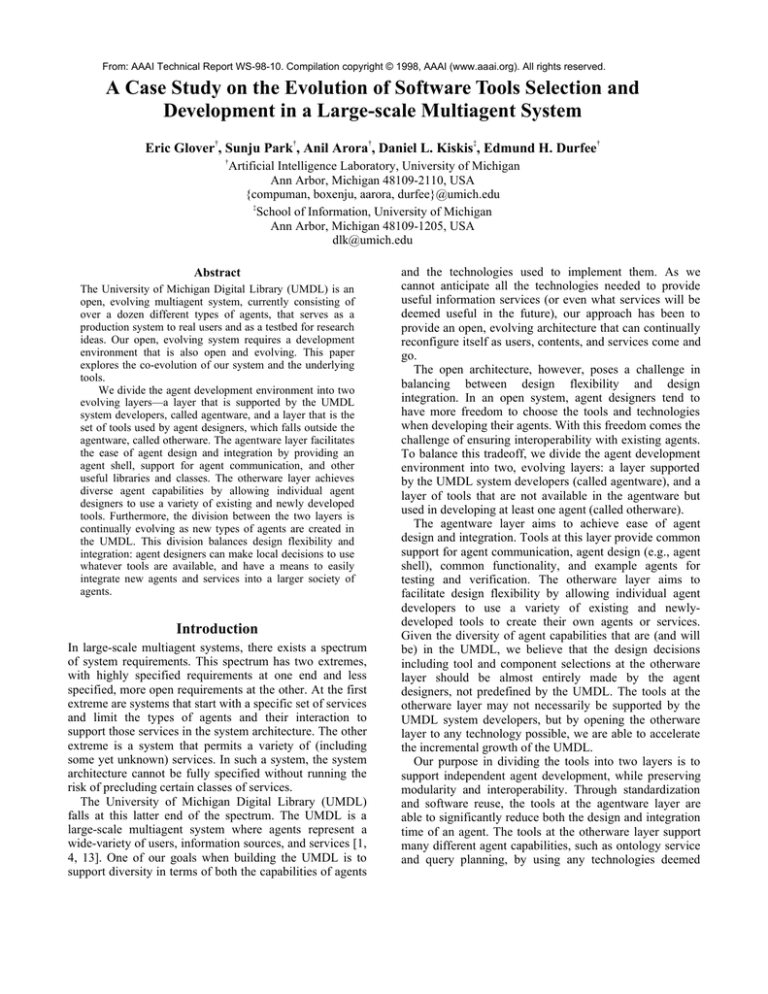
From: AAAI Technical Report WS-98-10. Compilation copyright © 1998, AAAI (www.aaai.org). All rights reserved.
A Case Study on the Evolution of Software Tools Selection and
Development in a Large-scale Multiagent System
Eric Glover†, Sunju Park†, Anil Arora†, Daniel L. Kiskis‡, Edmund H. Durfee†
†
Artificial Intelligence Laboratory, University of Michigan
Ann Arbor, Michigan 48109-2110, USA
{compuman, boxenju, aarora, durfee}@umich.edu
‡
School of Information, University of Michigan
Ann Arbor, Michigan 48109-1205, USA
dlk@umich.edu
Abstract
The University of Michigan Digital Library (UMDL) is an
open, evolving multiagent system, currently consisting of
over a dozen different types of agents, that serves as a
production system to real users and as a testbed for research
ideas. Our open, evolving system requires a development
environment that is also open and evolving. This paper
explores the co-evolution of our system and the underlying
tools.
We divide the agent development environment into two
evolving layers—a layer that is supported by the UMDL
system developers, called agentware, and a layer that is the
set of tools used by agent designers, which falls outside the
agentware, called otherware. The agentware layer facilitates
the ease of agent design and integration by providing an
agent shell, support for agent communication, and other
useful libraries and classes. The otherware layer achieves
diverse agent capabilities by allowing individual agent
designers to use a variety of existing and newly developed
tools. Furthermore, the division between the two layers is
continually evolving as new types of agents are created in
the UMDL. This division balances design flexibility and
integration: agent designers can make local decisions to use
whatever tools are available, and have a means to easily
integrate new agents and services into a larger society of
agents.
Introduction
In large-scale multiagent systems, there exists a spectrum
of system requirements. This spectrum has two extremes,
with highly specified requirements at one end and less
specified, more open requirements at the other. At the first
extreme are systems that start with a specific set of services
and limit the types of agents and their interaction to
support those services in the system architecture. The other
extreme is a system that permits a variety of (including
some yet unknown) services. In such a system, the system
architecture cannot be fully specified without running the
risk of precluding certain classes of services.
The University of Michigan Digital Library (UMDL)
falls at this latter end of the spectrum. The UMDL is a
large-scale multiagent system where agents represent a
wide-variety of users, information sources, and services [1,
4, 13]. One of our goals when building the UMDL is to
support diversity in terms of both the capabilities of agents
and the technologies used to implement them. As we
cannot anticipate all the technologies needed to provide
useful information services (or even what services will be
deemed useful in the future), our approach has been to
provide an open, evolving architecture that can continually
reconfigure itself as users, contents, and services come and
go.
The open architecture, however, poses a challenge in
balancing between design flexibility and design
integration. In an open system, agent designers tend to
have more freedom to choose the tools and technologies
when developing their agents. With this freedom comes the
challenge of ensuring interoperability with existing agents.
To balance this tradeoff, we divide the agent development
environment into two, evolving layers: a layer supported
by the UMDL system developers (called agentware), and a
layer of tools that are not available in the agentware but
used in developing at least one agent (called otherware).
The agentware layer aims to achieve ease of agent
design and integration. Tools at this layer provide common
support for agent communication, agent design (e.g., agent
shell), common functionality, and example agents for
testing and verification. The otherware layer aims to
facilitate design flexibility by allowing individual agent
developers to use a variety of existing and newlydeveloped tools to create their own agents or services.
Given the diversity of agent capabilities that are (and will
be) in the UMDL, we believe that the design decisions
including tool and component selections at the otherware
layer should be almost entirely made by the agent
designers, not predefined by the UMDL. The tools at the
otherware layer may not necessarily be supported by the
UMDL system developers, but by opening the otherware
layer to any technology possible, we are able to accelerate
the incremental growth of the UMDL.
Our purpose in dividing the tools into two layers is to
support independent agent development, while preserving
modularity and interoperability. Through standardization
and software reuse, the tools at the agentware layer are
able to significantly reduce both the design and integration
time of an agent. The tools at the otherware layer support
many different agent capabilities, such as ontology service
and query planning, by using any technologies deemed
appropriate. The division between two layers is not fixed.
For example, the agentware layer is continually evolving to
accommodate widely accepted tools from the otherware
layer. Similarly, a new set of tools may become a part of
otherware as new agents and services are created.
Throughout the duration of our project, our tools have
evolved to encourage and facilitate (1) creation of new
instances of existing agents, (2) creation of wholly new
types of agents, and (3) interoperability among agents. As
a result, the UMDL contains many integrated but diverse
services, each one independently designed and
implemented, while retaining a high level of intra-agent
activities.
In the following, we describe the UMDL system, the
agent architecture, and the agent development
environment. Then we examine the evolution of the
UMDL and how the tools and agent components from both
layers are used and evolved accordingly. Finally, we
conclude with a summary of the lessons we have learned.
The UMDL System and Agent Architecture
In this section, we briefly describe the UMDL system and
its agent architecture [1, 4, 10].
The UMDL is designed to provide digital library
services in a distributed, heterogeneous information
environment. It is structured as a collection of agents that
collectively provide these services by dynamically
configuring their interactions as needed. Higher level
activities such as team formation are accomplished via
intra-agent communication protocols.
We distinguish three broad classes of agents populating
the UMDL: User Interface Agents (UIAs), Collection
Interface Agents (CIAs), and Mediator Agents. The UIAs
manage the presentation of information, maintain user
models, and in general represent the end users of the digital
library. The CIAs provide access and search services for
the library collections, and represent the publishers and
other owners of these collections. In between, many types
of mediator agents perform a variety of services (e.g.,
monitoring the progress of the query, transmitting the
results of a query, providing the ontology service, etc.).
Among the mediator agents are specialized system agents
called facilitators, such as the registry agent (that supports
the location of relevant agents) and the auction agents (that
facilitate information markets). As new services are
desired, new types of agents are created to provide the
services and added to the system.
Agents are implemented as Unix processes that
communicate using common network protocols (i.e.,
TCP/IP). We choose distributed-object technology as the
basis for agent communication; we use the CORBA
(Common Object Request Brokerage Architecture)
distributed-object standard [3], and in particular, Xerox’s
ILU (Inter-Language Unification) implementation of it [9].
The CORBA standard provides us with the basic
mechanisms we need, and ILU is freely available, allowing
us to take advantage of CORBA with little investment.
Agent communication tools define for each agent a
communication interface, embodied as an ILU object that
handles communication with other agents’ communication
objects.
The interface exported by the communication objects
implements KQML (Knowledge Query and Manipulation
Language) performatives and their (possibly nested)
argument lists [5]. KQML, being neutral to details of the
“content” argument that varies with agents and services,
makes it well suited for supporting the diverse uses of the
UMDL.
To facilitate the agent design, we provide an agent
shell—a C++ Agent class. The Agent class encapsulates
the communication mechanisms. Individual agents are
implemented by subclassing this class, thus inheriting the
ability to communicate through our standard mechanisms.
For convenience, we have added to our Agent class
some functionality tailored to particular services. For
example, since a required capability of a UMDL agent is
that it must register with the UMDL registry so that other
agents can find it, we have embedded this functionality
into our Agent class, thus relieving the duplicated
programming of registration protocol for every agent
created. Of course, any special functionality not inherent to
the UMDL architectural requirements can easily be
removed or ignored for different agents.
For each specific functionality of an agent, the agent
designers may introduce additional components to the ones
that are supported by the UMDL system developers. The
UMDL places no restriction on the tools and components
used at the otherware layer.
Agent Development Environment: Agentware
and Otherware
In this section, we discuss the tools of the agentware and
otherware layers and present an example of how an agent
is developed. Agentware is the collection of various
components and tools that are supported by the UMDL
developers. Otherware is our name for third-party
components and tools that are not integrated into the
agentware, but have been involved in the building of at
least one agent. In addition to the agentware and
otherware, there are a number of basic tools, consisting of
the compilation and basic libraries that provide the base for
development. One such tool is C++, our primary
programming language. We take advantage of C++’s
object-oriented features to build the agent classes, as
discussed in the next subsection. We also use the
RogueWave Tools.h++ library [12]. The Tools.h++ library
provides useful C++ classes such as a string class,
container classes (e.g. vectors, hash tables) in both generic
(Smalltalk-like) and template forms.
Agentware
The agentware is a collection of various component
libraries and tools that are supported as a base for UMDL
agents. The primary component of the agentware is the
Agent class. This C++ class defines a set of
communication
APIs
(Application
Programmer’s
Interfaces) for sending and receiving messages as well as
encapsulating the underlying CORBA communication
mechanisms. All agents subclass the Agent class and
inherit these standard communication mechanisms. The
agent class defines a set of KQML APIs for sending and
receiving KQML messages. Each KQML performative has
a unique send function and a unique receive virtual
function. Each receive virtual function defaults to
responding with “sorry” to indicate that the performative is
not supported by the agent. To receive certain
performatives, therefore, the agent designer overrides the
appropriate virtual functions.
Along with the Agent class, the agentware has
component libraries that are not required by the agents but
provide useful functionality. One such library is the Agent
Toolkit library. The Agent Toolkit library is a repository of
C++ classes that are basic utility classes not found in the
RogueWave or in the base agent classes. It contains
various classes such as a thread class, a mutual exclusion
lock, a semaphore class, and a class to register callback
functions to respond to inputs on specified file descriptors.
The agentware also consists of support tools that
facilitate agent development. An example is the Testing
Client who reads in a file containing messages, and via a
command line interface, allows agent developers to send
those messages to a specified agent and to display the
replies that the agent returns. The Testing Client provides
agent developers with a way to verify the interoperability
with other agents at the development phase.
The agentware also contains code that provides
integration with the otherware. One example is the code
that integrates the University of Michigan Procedural
Reasoning System (UM-PRS) [7, 11] with the Agent class.
This integration code was incorporated into the agentware
so that other developers could take advantage of UM-PRS
without rewriting that integration code.
Otherware
While the agentware provides a rich set of tools for
building agents, it is often desirable to incorporate thirdparty software into an agent. It is this software that we
refer to as otherware. A number of different software
packages have been used in UMDL agents. We mentioned
UM-PRS as one. Another example is Loom [2], a
description logic classification system used in the Service
Classification Agent (SCA) [15]. Additional otherware
includes client libraries for Sybase, Z39.50 [8], and the
FTL (Full Text Lexicographer) [6] search engine.
Developing an Agent
As an example, we examine how the SCA was
developed. The SCA maintains a dynamic ontology of
agent capabilities that allows for automatic classification of
services within the UMDL. Instead of building a
description logic classification system from scratch, the
developer of the SCA decided to use Loom, the most
expressive of the KL-ONE systems.
Integration of Loom with the existing Agent class,
however, posed a challenge because Loom is written in
1
Lisp and the Agent class is implemented in C++. The
solution was to build a driver that spawns two child
processes, one the agent and one Allegro Lisp, which
would communicate via a pipe. The agent translates
messages received via the KQML API into messages that it
then ships through the pipe. The Lisp process receives the
data from the pipe and performs the classification service.
The resulting classification is then sent back though the
pipe and packaged up by the agent to reply to the original
sender.
As in the example, there are tradeoffs in our two-layered
development environment: the SCA developer was able to
use the power of Loom, but needed extra work on
integration.
Evolution of the UMDL and the Agentware
In this section, we examine the evolution of the UMDL,
and the associated agentware used to create agents. Our
original objective of an open architecture to facilitate
integration of a variety of different services was quite
ambitious. Nearly four years since the first production
system, there are over a dozen different types of agents and
dozens of different instances, each with unique services.
This large set of services evolved over time. Paralleling
this evolution was an improvement in the supported
agentware available to agent designers.
The early versions of the agentware provided only the
bare minimum set of libraries necessary for intra-agent
communication. The basic KQML and lower level
(CORBA-ILU) code are the only agent components
mandated by the architecture. Over time, the agentware has
grown to include some special purpose libraries, such as
the ability to register, extra support for asynchronous
communication through mailboxes, the ability to fetch web
pages, and numerous others. The expansion of the
agentware is one of many software related “evolutions”
occurring within our project.
The collection of software libraries, or agentware, is our
agent design toolkit. Unlike a monolithic toolkit, our agent
designers are not restricted to using code and functionality
found only in the agentware. Likewise, the agentware itself
is not limited to a pre-defined set of architectural
specifications. Over time, our agentware has expanded to
fill the needs of a monolithic toolkit, without removing the
individual designer’s flexibility necessary to enable a
cornucopia of services. These needs include the ability to
quickly prototype an agent, and ease of integration with
existing agents.
The growth of our system has demonstrated many
simultaneous evolutions. First, is the gradual expansion of
the agentware due to natural addition of new functionality.
1
A C++ version of Loom has recently been released, but the
system available when the SCA was created was written in Lisp.
HTTP
JAVA
Sybase
Otherware
PRS
CORBA
Agentware
KQML
HTTP
CORBA
JAVA
Sybase
Otherware
Agentware
KQML
Registration
PRS
Registration
Improved Agent shell
(a)
(b)
LOOM
HTTP
JAVA
Sybase
Otherware
PRS
CORBA
Agentware
KQML
Registration
Improved Agent shell
(c)
HTTP
CORBA
JAVA
Sybase
Otherware
PRS
Agentware
KQML
Registration
Improved Agent shell
(d)
Figure 1. Evolution of Agentware and Otherware
The agentware has been slowly expanded to provide
support demanded by the programmers: support both in
terms of low-level functionality (e.g., modifying the lowlevel code to enable sending of typed elements, as opposed
to only strings), and higher level demands (e.g., an
improved agent shell). Second, is the expansion of the
otherware due to the creation of new categories of agents
and services. Each time a new agent type is created, the
agent programmers have full flexibility to choose their own
tools. Such tools include languages (compilers) or
commercially available products, such as Sybase (used by
the registry agent) or Loom (used by the SCA). This
expansion on the otherware level in turn causes the
agentware to change. A third type of evolution happens at
2
the gradual shifting of agents from the research testbed
into the production system. As agents are moved over to
the production system, the change in requirements often
requires code changes, which affects the agentware. The
resulting agentware simplifies and encourages new agent
design.
Figure 1-(a) shows some of the components (APIs and
libraries) of the agentware and otherware layers. When the
agentware grows because of the addition of new
functionality, such as the addition of an improved agent
shell, as shown in Figure 1-(b), the ability to create new
agents is also improved. When tools or libraries in the
otherware layer become popular, they sometimes become
part of the agentware as shown in Figure 1-(c). When new
agents are created, new tools or libraries are often used,
therefore expanding the otherware, as shown in Figure 12
The research testbed shares the same resources as the production
system, but by convention agents choose not to communicate
across these lines unless necessary. Research testbed refers to the
collection of agents used for research-related activities, while the
production system refers to the agents involved with service
provision to real users (middle and high school students).
(d). Each of these changes facilitates the others. Improving
the agentware makes creation of new agents simpler,
encouraging agent designers to create more agents. As the
agentware grows due to the incorporation of code or tools,
once used only by a single agent designer, newer services
are available to expand the functionality of existing agents,
as well as create new ones. When new agents are created,
there are more opportunities to expand the otherware.
An Example: The Task Planner Agent
To illustrate these evolutions, we describe the evolution of
the Task Planner Agent (TPA). The TPA is a mediator
agent designed to act as a middleman between the User
Interface Agent (UIA) and the registry by accepting
queries and returning lists of relevant Collection Interface
Agents (CIAs) [14]. In the earliest stages of the project,
there were four types of agents, CIAs, UIAs, TPAs, and a
registry. The TPA simply passed requests from the UIA to
the registry with no additional processing. At present there
are at least four wholly different “flavors” of TPAs,
ranging from those with advanced learning to the
production-system TPA which incorporates auction
protocols to ensure proper system load balancing. The
evolution of the TPA is one example of the expansion of
the agentware, as well a demonstration of the importance
of design flexibility provided by the two-layered design
environment. In addition, the current TPAs show how the
expanded agentware simplifies agent creation.
There are five critical stages in the evolution of the TPA.
At each stage, there was either a direct or indirect
agentware evolution occurring. The first TPA, the simplest
one, was built prior to the incorporation of CORBA into
our agentware, and like all new agents, was significantly
less functional than the current varieties. The second
evolution occurred as the research interests called for the
incorporation of an advanced planning and reasoning
system (UM-PRS) to function as the core of the agent,
allowing advanced AI functionality. The third stage
demonstrated the flexibility of our system by incorporating
the services of other mediator agents, a BSO (Broad
System of Ordering) and a NASA Thesaurus. In addition,
the agentware grew through the addition of mailbox
communication support. At this stage, a break between the
interests of research and user service provision occurred.
This break demonstrates the flexibility of our agentware
and architecture by allowing two wholly different
development efforts to occur simultaneously. The fourth
stage, inside the research testbed, demonstrated the ease of
agent design (using agentware and UM-PRS), by creating
different flavors of TPAs. At the fifth and final stage, the
current production system version was created, which
demonstrated the ease of integration. For example, the
research on the auction protocols resulting in
advancements of the agentware was incorporated into the
production version of the TPA with ease.
Stage 1: The Initial TPA. The initial TPA was intended to
demonstrate the concept of a mediator agent. Its
functionality was limited, and it was built through manual
coding in C++. At this point, the agentware provided only
the most basic socket-level interfaces.
Stage 2: Integration of CORBA and UM-PRS. The
experiments with the simpler agents at the first stage
pointed towards the use of CORBA as the minimum agent
requirements. Using CORBA as opposed to socket-level
communication (KQML on TCP/IP sockets) enables more
complicated structures to be communicated between
agents, as well as providing a solid framework from which
to build future agents.
Another major evolution in the TPA was the decision to
use UM-PRS as the agent control language. UM-PRS is a
proactive procedural reasoning system, which allows
advanced reasoning about multiple goals implemented in a
belief desire intention (BDI) framework. Incorporation of
UM-PRS demonstrates the flexibility of our design
environment as the agent designers were able to choose
their own control language. The incorporation of UM-PRS
allows for a much richer set of functionality. Since UMPRS allows arbitrary knowledge areas and rules, the TPA
was given more autonomy, and its functionality could be
easily modified through changing of the UM-PRS
knowledge areas. Our agent development environment is
such that should some other agent control language be
desired, it could be easily added.
Stage 3: Mailboxes, Thesauri, and New Objectives. The
third point in the evolution of the TPA, with respect to
changes in the agentware, was the modification of the
nature of the interaction between UM-PRS and the
agentware. For performance and reliability reasons, we
integrated the UM-PRS into the same process as the agent.
The UM-PRS and ILU control loops were run in different
threads of the same process and communicated via a global
mailbox. The mailbox communication scheme was rapidly
incorporated into the agentware, and is currently used in all
UMDL agents which use asynchronous communication.
In addition to the expansion of the agentware, we had
the addition of two new agent classes, a BSO (Broad
System of Ordering) agent and a NASA Thesaurus agent.
With these agent services, the TPA could broaden or
narrow queries and find alternate terms, aiding in the
search process. The low-level agentware provided the
necessary communication infrastructure for all the agents,
and the decision to use CORBA and KQML enabled
simple intra-agent communication. Since the KQML
communication comes “for free” from the agentware, the
ability to talk to new agents required no modification,
except for the simple addition of the rules to speak the
appropriate agent-specific protocols (which is simpler than
making custom socket-level communication code). In
addition, UM-PRS allowed developers to change the way
the TPA processes each request with respect to the newly
available services.
Stage 4: A Split between the Production System and the
Research Testbed. Up until this point, the UM-PRS TPA
was sufficient for both research and production needs.
However, as the time to deploy the production system
approached, the requirements of the production and
research systems diverged. For the production system, the
TPA needed to exhibit high performance and
dependability, and only a fixed set of functions was
required. The needs of research suggested an ideal
opportunity to experiment with the flexibility of UM-PRS
and to try many different experiments with regard to the
unique intelligence of the TPA.
Using the UM-PRS TPA as a prototype, a smaller, more
efficient TPA was built for the production system. It
sacrificed the flexibility of UM-PRS in favor of run-time
performance. The lineage of the UM-PRS TPA was
continued for research purposes. Since both TPAs were
implemented using the same agentware and supported the
same performatives, the switch from one TPA to the other
was transparent to the rest of the system.
The development lines of other agents had similar splits
at this time. The result was the formation of two separate
systems: the production system and the research testbed.
Although there are two systems, the division is only a
logical one. The agents share common resources and have
the ability to interact across the testbed boundaries. The
distinction is one of policy, not a physical partition. The
fact that the two systems are only logically different
facilitates moving of agents from one system to the other.
An agent in the research testbed that has functionality
desired by the production system can be accessible to the
production system agents serving students using the
UMDL. Likewise, new agents and improved agentware
produced for the production system are immediately
available to the research testbed.
Stage 5: Continued Evolution of the TPA. The current
production-system TPA, which processes hundreds of
queries a day, was built from the TPA of the third
evolution stage. The generality of UM-PRS (and runtime
overhead required to provide it) was not necessary given
routine patterns of UMDL usage by students. Therefore,
the TPA was re-implemented as a simpler, faster, but less
flexible, multithreaded C++ program.
During the time this new TPA was being built, research
was being done on the use of auctions as a means of load
balancing and resource distribution. So that other agents
could take advantage of this research, the code developed
for the auctions was incorporated into the agentware. Once
in the agentware, adding it to the production TPA was
simple. This is an example where the evolving agentware
simplified the addition of services to existing agents.
In the research testbed, three different types of TPAs
have been developed. A TPA with a learning algorithm and
a TPA with strategic reasoning capability have been
developed to test individual graduate-student research, and
a third, “dumb” TPA has been also made for comparison.
UM-PRS and agentware make it easy to create new
instances of the agent, each with wholly different goals and
procedures. The ease by which new research ideas can be
added to an agent demonstrates the power of the agentware
and the flexibility of our development environment.
At present, the agentware has a set of optional libraries
available for agent designers, and its flexibility is
demonstrated by the ability to simultaneously develop
different flavors of an agent, each with completely
different purposes and requirements.
Lessons Learned
As the UMDL evolved, so did our development
environment. The UMDL evolved in a path strongly
affected by the architectural and policy decisions, as well
as through the hard work and ideas of the many agent
builders. The evolution of the UMDL with respect to the
new services and new agents affected the tools such that
future agent design was improved. Along this path, there
were many challenges.
Throughout our project, we have learned that it is
possible to have a large multiagent system that works. Our
current system is actively used in the local middle and high
schools. To date, over 1000 school children have used it as
part of their regular science classes. It also provides a
research testbed where new agent models and designs may
be tried out.
Our decision to allow third party tools has provided
extensive flexibility but has come at a price. Tools not
made specifically for the agentware may have difficulties
in integration and have no guarantee of support. Some
examples include UM-PRS and Loom. UM-PRS required
the addition of many new tools and libraries to the
agentware, such as the mailbox code. Loom required the
programming of Unix sockets as a means of
communication between the LISP engine and the C++
agentware core. A benefit of this, however, is that the
agentware has encompassed the mechanisms that were
developed for such integration.
A second lesson is that an open system, sometimes,
results in redundant work. Because we allow designers
flexibility in tool choices, it may be the case that the same
task is done by using two different tools. One example is
the inclusion of HTTP support for our agents. At one point,
there were three different agents which each utilized
independent HTTP libraries. Eventually, one HTTP library
was selected and added to the agentware. It has since been
used to develop other agents, eliminating the need for the
designers to maintain their own versions of the library.
A third lesson is that implementing a more general
architecture requires more work. For example, since the
architecture made no commitment with respect to the
communication protocols, both synchronous and
asynchronous communication were implemented. If the
system were mandated that a single type was used, then the
total work may have been less. However, current agent
designers take advantage of the ability to use either model,
and the generality is worth the extra effort.
A fourth lesson is that, in an open system, the core set of
functionality evolves slowly over time instead of being
specified from the start. Many of the current agents were
designed by graduate students for their research. In the
early part of the project, the agentware was much smaller
and poorly documented, making creation of new agents
difficult. If a monolithic toolkit were available, more
agents may have appeared sooner, but those agents would
have been limited by the capabilities of the toolkit.
Currently, the agentware contains libraries for almost every
task a new agent designer would desire. In the event a
particular functionality cannot be realized by the
agentware, the designer is always free to choose third party
tools while providing the necessary means of integration.
Despite the problems encountered while learning these
lessons, the high level of flexibility provides many
opportunities that might not have otherwise been present.
By separating the agentware and otherware layers, agent
designers can easily create agents that interact within a
large society of agents and can make local decisions on
tools related to a specific functionality of each agent. The
current mix of agents is diverse in ways not imaginable
during the early days of the project. We currently have
agents capable of re-ordering search results, crawling the
web, planning queries, recommending results, suggesting
alternate terms, or topics, using advanced learning to
choose the best resources, automating service
classification, auctioning services and goods, and
providing a plethora of diverse content. This list is growing
every day, as is the underlying set of tools to support it.
Acknowledgments
We would particularly like to thank José Vidal and Peter
Weinstein for sharing their development experiences with
UM-PRS and Loom. We would also like to thank the rest
of the UMDL Service Market Society group (Bill
Birmingham, Tracy Mullen, and Bill Walsh) for their
comments and ideas. This project has been funded in part
by the joint NSF/ARPA/NASA Digital Libraries Initiative
under CERA IRI-9411287.
References
[1] Atkins, D.E., Birmingham, W.P., Durfee, E.H.,
Glover, E.J., Mullen, T., Rundensteiner, E.A.,
Soloway, E., Vidal, J.M., and Wellman, M.P., 1996.
Toward Inquiry-Based Education Through Interacting
Software Agents. IEEE Computer 29(5):69-76.
[2] Brill, D., 1993. Loom Reference Manual, Version
2.0, University of Southern California.
[3] The Common Object Request Broker: Architecture
and Specification, Revision 1.1. Framingham,
Massachusettes, USA: Object Management Group.
[4] Durfee, E.H., Kiskis, D.L., and Birmingham, W.P.,
1997. The Agent Architecture of the University of
Michigan Digital Library. IEE British Computer
Society Proceedings on Software Engineering 144(1).
[5] Finin, T., Fritzson, R., McKay, D., and McEntire, R.,
1994. KQML - An Information and Knowledge
Exchange Protocol. In Knowledge Building and
Knowledge Sharing,
[6] Full Text Lexicographer Homepage.
http://kalex.engin.umich.edu/ftl/.
[7] Huber, M.J., Lee, J., Kenny, P.G., and Durfee, E.H.,
1994. UM-PRS V3.0 Programmer and Reference
Guide, University of Michigan, Artificial Intelligence
Laboratory.
[8] Information Retrieval (Z39.50): Application Service
Definition and Protocol Specification, ANSI/NISO,
Z39.50 - 1995, Library of Congress.
http://lcweb.loc.gov/z3950/agency.
[9] Inter-Language Unification Homepage.
ftp://ftp.parc.xerox.com/pub/ilu/ilu
.html.
[10] Kiskis, D., 1995. UMDL Architecture Requirements
Analysis, Internal Report, School of Information and
Library Studies, University of Michigan.
[11] Lee, J., Huber, M.J., Durfee, E.H., and Kenny, P.G.,
1994. UM-PRS: An Implementation of the
Procedural Reasoning System for Multirobot
Applications. Proceedings of the AIAA/NASA
Conference on Intelligent Robotics in Field, Factory,
and Space.
[12] Tools.h++ Homepage.
http://www.roguewave.com/products/to
ols/tools.html.
[13] University of Michigan Digital Library Homepage.
http://www.si.umich.edu/UMDL/.
[14] Vidal, J.M., and Durfee, E.H., 1995. Task Planning
Agents in the UMDL. Proceedings of the Fourth
International Conference on Information and
Knowledge Management (CIKM) Workshop on
Intelligent Information Agents.
[15] Weinstein, P. and Birmingham, W.P., 1997. Runtime
Classification of Agent Services. Proceedings of
theAAAI-97 Spring Symposium on Ontological
Engineering.

